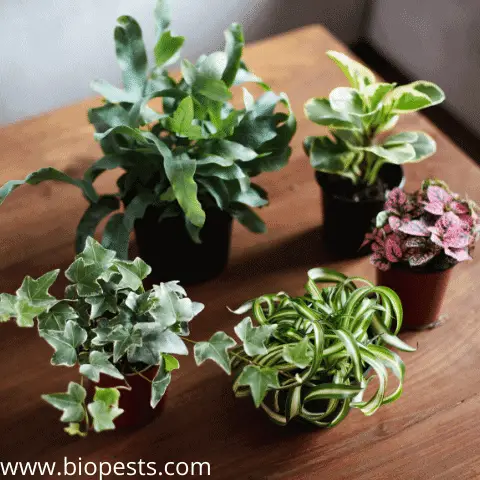I used to think that I couldn’t keep a single houseplant alive. But I seem to have figured a few things out, and my potted houseplant collection is growing nicely. I’ve noticed that indoor plants can look incredible on their own but clustering them together in groups or even in the same pot is an absolute treat for the eyes. I’m getting the feeling that it is time for me to level up and experiment.
You can mix houseplants in one pot by following a few guidelines:
- Houseplants in the same pot must have similar light, nutrition, and water needs
- Keep contrast and balance in mind by mixing tall, short, leafy, and simple
- Consider your color choices – choose colors that will complement each other
We combine plants in our garden beds outside all the time, so planting combinations of plants in pots is quite logical. Plus, this method is a bit of a life hack for novice plant parents like me, as I’m not great at remembering which plants should be watered on which day. I have done the research and have come up with some ideas for creating some beautiful potted houseplant arrangements. I’ve put together some inspiration for your next houseplant combination project and some detailed guidelines on how to do it.
Episcia, Calathea, and Lime Pothos
With similar water and soil requirements, Episcia, Calathea, and Neon Pothos make an exquisite combination. The different shades of greens mixed in one container work beautifully and have a lovely calming effect.
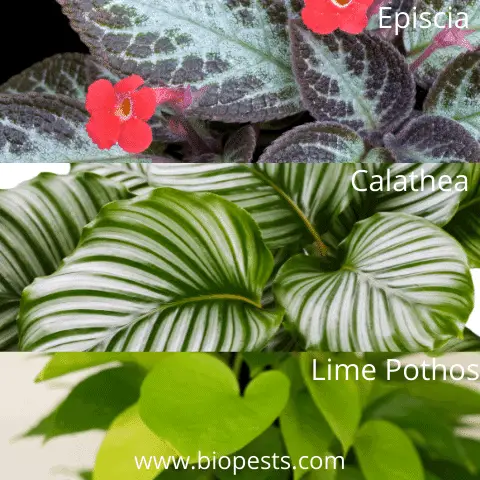
Episcia
Episcia, native to Central and South America and the West Indies, is a close relative of the African Violet but needs more care. It is a trailing plant with colorful textured leaves and small, pretty flowers.
Calathea
The Calathea is a tropical houseplant, loved for its foliage – each variant has different striking patterned leaves. Watch as the Calathea’s leaves change position during the day as the temperature, light, and humidity change.
Neon Pothos
The Neon Pothos has a stunning chartreuse green leaf color. Its vines look amazing as they fall freely or trail along a shelf.
Peace Lily, Kalanchoe, and Arrowhead
This is an easy combination to grow and maintain. The aptly named Peace Lily provides height and pairs well with the thick succulent leaves of Kalanchoe and the trailing greenery of the Arrowhead. An important note: the Arrowhead is toxic to people and animals, and the Kalanchoe is toxic to animals, so make sure that this combination is not in reach of curious children and pets.
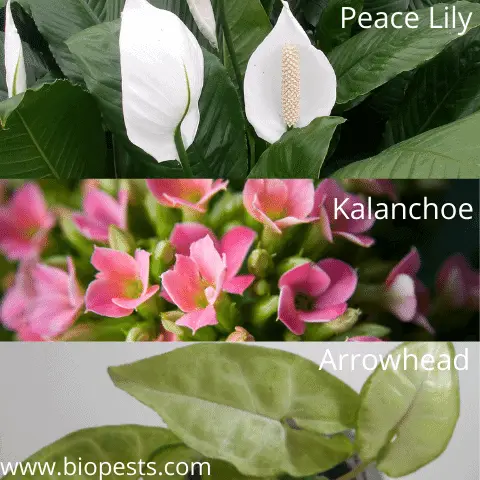
Peace Lily
Peace lilies are excellent houseplants with their white “flowers” and dark green leaves. As a bonus, they clean the air of their environment. The part usually thought of as the flower is actually a leaf bract that grows as a protective hood over the flowers.
Kalanchoe
Kalanchoes are beautiful succulents with lovely foliage colors and brightly colored flowers. They look charming in containers and are quite dramatic when planted in groups.
Arrowhead
The Arrowhead is an easy to care for vine plant, with distinctive arrow-shaped leaves and variegated coloring.
Monstera Deliciosa and Heartleaf Philodendron
The Heartleaf Philodendron and the Monstera Deliciosa work well together because they are physically similar, enjoy the same living conditions, and are very low maintenance.
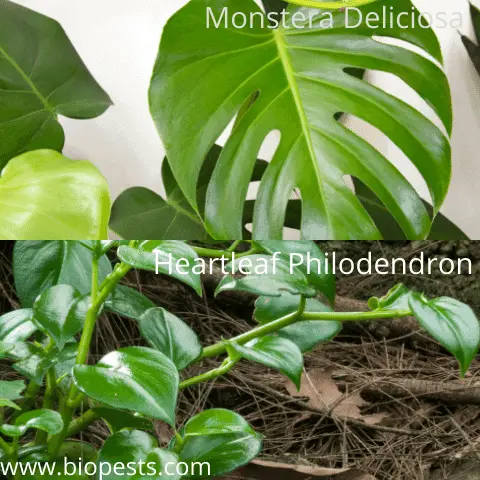
Monstera Deliciosa
Famous for its natural leaf holes, the Monstera Deliciosa has a cute nickname – the Swiss Cheese Plant. These leaf-holes are called fenestrations. They are native to South America.
Heartleaf Philodendron
The Heartleaf Philodendron (or the Sweetheart Plant) is extremely popular for beginner plant collectors and loves to trail or climb.
Bromeliad, Florida Gold Dracaenas, and Satin Pothos
This is another beautiful combination of greens and varying leaf shapes that look fantastic when combined in one pot.
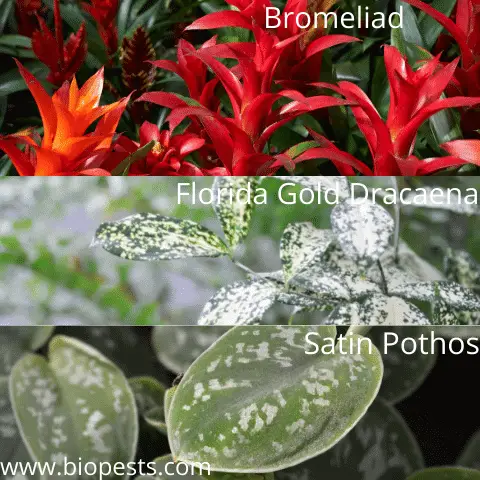
Bromeliad
The Bromeliad is popular for its flower and its striking, beautiful foliage – its leaves are red, green, purple, orange, and yellow and details such as bands, stripes, and spots.
Florida Gold Dracaenas
Also known as the Dracaena’ Florida Beauty’ or the Gold Dust Dracaena, it has glossy green foliage with yellow speckles. The variegation starts as yellow and becomes white as it ages.
Satin Pothos
The Satin Pothos has heart-shaped leaves with silvery grey splotches, making them look shiny. Different cultivars affect the intensity of the variegation.
Philodendron, Pothos, and Spider Plant
This is a simple combination that creates a fabulous jungle look. We’ve already spoken about the Philodendron and the Pothos in some of the other combinations, so let’s look at the Spider Plant.
Spider Plant
It is a very cool plant to have in your home with its unique spider-like foliage and its ability to remove harmful toxins from the air. There are a few variations of the Spider plant with which you can experiment.

Snake Plant, Yucca, and ZZ Plant
This is a strong and dramatic combination which is also very easy to maintain as the plants are hardy and don’t need a lot of love.

The Snake Plant
The Snake Plant is a resilient succulent, also known as the Mother-in-law’s Tongue. It is native to Asia and Africa, and you’ll recognize it by its evergreen, upright sword-shaped leaves. They almost look like artificial foliage.
Yucca
The Yucca is a classic house plant with long, swordlike leaves. The leaves grow out in a rosette from the top of a bare trunk.
ZZ Plant
The ZZ Plant has broad dark green waxy leaves which reflect sunlight. It is known for its toxin removing qualities.
Firecrackers and Table Ferns
The Firecracker and Fern combo makes for a vibrant showy arrangement with loads of full foliage.
Firecrackers
The Firecracker is made up of clusters of scarlet tubular flowers which look like little firecrackers. The slender stems fall out in long cascades, which look amazing spilling out of a container. It is also known as the Coral plant and Coral Fountain plant.
Table Fern
Also known as the Brake fern, it is a relatively easy fern to care for with fragile fronds. The leaves are variegated and bright, and its full foliage is very pleasing to the eye.
Pink Dracaena, Waffle Plant, Prayer Plant, and Black Cardinal Philodendron
This is a dramatic, sexy combination of plants that will get your visitors talking. It looks incredible in a black pot.
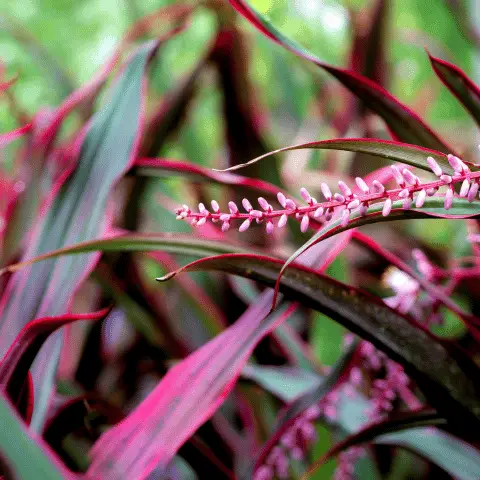
Pink Dracaena
The Pink Dracaena is also known as Pretty in Pink or Madagascar Dragon Tree. It is a vibrant, easy-going plant with swordlike leaves and woody stems. The pink of the leaves makes quite a statement.
Purple Waffle Plant
The Purple Waffle plant or Hemigraphis Exotica has leaves that are green on top and have a bright purple underside. The leaf texture is ruffled and wrinkly, making it a great contrast to other types of foliage.
Prayer Plant
The Prayer Plant or Herringbone Plant (Maranta leuroneura) has mesmerizing foliage with curved reddish segments and layers of green. It got its sweet name from its habit of folding up its leaves each night ‘to pray’.
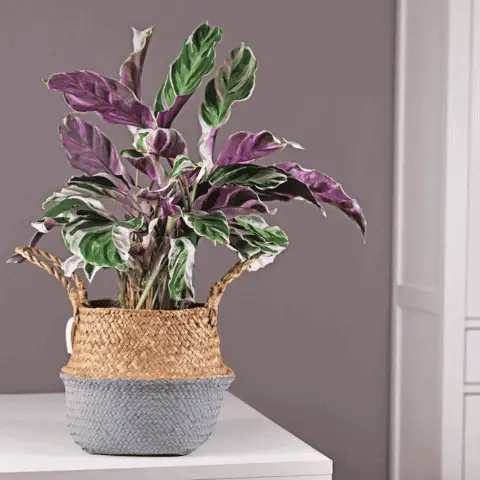
Black Cardinal Philodendron
When the Philodendron’ Black Cardinal’ grows new leaves, they emerge as a burgundy red. As the leaves mature, they become dark green and eventually will turn almost black.
Aeonium, Tradescantia, Graptosedum California Sunset and Mother of Thousands
This is a hardy little succulent combination for your plant collection – great if you’re a bit forgetful about watering.
Aeoniums
Aeoniums are fleshy, succulent plants native to Madeira, the Canary Islands, and North Africa. They have rosettes of glossy, waxy leaves, and they may produce clusters of tiny flowers. They’re most popular for their distinctive shapes and colors of foliage.
Tradescantia
The Tradescantia is also known as a Wandering Jew plant. It is a creeping ground cover succulent. Its flowing tendrils look lovely hanging out of a pot
Graptosedum California Sunset
Graptosedum’ California sunset’ is a popular succulent plant with its sunset colors of orange and compact pink rosettes.
Mother of Thousands
The most interesting feature of the Mother of Thousands (Kalanchoe daigremontiana) is that it has sweet little baby plantlets which continually appear on the tips of the large leaves.
Gollum jade plant, Drunkard’s Dream, and Window-leaved Haworthia
Let’s get a bit fantastical and mystical with this succulent combination.
Gollum Jade
The Gollum Jade succulent (Crassula ovata ‘Gollum’) inherited its nickname from Tolkein’s Lord of the Rings. It has long tubular leaves that are tipped in red and curl inward. It occasionally produces small, star-like pinkish flowers.
Drunkard’s Dream
Some other common names for Drunkard’s Dream (Hatiora salicornioides or Rhipsalis salicornioides) are the Dancing Bones Plant, the Spice Cactus, or the Bottle Cactus. You will immediately see how it got its funny names when you see it. This succulent plant produces an array of contorted stems with bottle-shaped joints and adds interest to a houseplant combination.

Window-leaved Haworthia
The Window-leaved Haworthia is also known as Cathedral Window Haworthia. It is an evergreen succulent with pale green fleshy leaves which become translucent at the tip. It is popular as a houseplant because it is so easy to grow and has low maintenance.
A Few Guidelines for Grouping Plants
After all that inspiration, are you ready to get going? Maybe you love some of the ideas above, or perhaps you’re feeling adventurous, and you want to try a few combinations of your own. We touched on the broader guidelines for mixing plants at the beginning of this article, but let’s go into a bit more detail below:
How Thirsty Are Your Plants?
Water is an essential consideration when grouping plants together. Combining a thirsty plant with a plant that likes to go dry in the same pot is a disastrous idea, and neither plant is likely to survive.
When watering, consider using rainwater or melted snow – plants love the natural minerals and respond exceptionally well to these. Try to avoid water that contains sodium.
Also, try not to wet the foliage when planting a few plants in the same pot. Instead, make sure that the entire soil mass is wet.
Consider the Lighting
It is crucial to think about what the plants’ light needs are. If all the plants in the group like the morning sun, you’re on your way to success, but if one likes shade and the other thrives in full sun, you shouldn’t put them together.
What Humidity Conditions Do the Plants Prefer?
Most plants live well in high humidity conditions. If you live in a cold area and heat your home, you make the air much drier, which humidity-loving plants may not love much. Grouping plants together helps with humidity.
You can also use a humidifier to help your plants to thrive or investigate creating a miniature biome where you add pebbles and water. If you want to mist your plants, make sure that all the plants in the combination enjoy misting. Bathrooms or kitchens also tend to be more humid.
What Temperatures Do the Plants Enjoy?
Houseplants vary in temperature preferences. Some might be great when placed near heating, and others might prefer drafty, cooler areas. It is essential to know which plants like what temperatures and only group plants with similar preferences together.
Drainage
All houseplants need good drainage, and good drainage is dependent on good quality organic potting soil. You need to remember that different plants like different soil types, so if you are mixing a few plants in one container, make sure that they all thrive in the same sort of soil.
Always choose a container with large drainage holes to avoid blockage. If there aren’t any holes, place a layer of pebbles in the base of your pot to make sure that none of the plants stand in water. Standing in water causes root rot and damages the plant.
Are the Plants Pet- and Child-friendly?
I mentioned a few plants in the combination inspiration ideas that are toxic to either pets, humans, or both. Group these sorts of plants where they’re out of reach of your inquisitive kidlets or furbabies.
Do the Plants Look Good Together?
Okay, so you’ve checked all the individual plants for their growth needs, and you’re ready to get potting. I suggest looking at colors that work together, either by contrast or as complementary colors. In terms of shapes, consider a tall plant, a shrubby plant, and a trailing vine type plant for a pleasing balance in your pots. Have fun!

